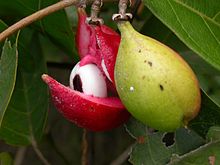|
Paullinia pinnata
Paullinia pinnata is a flowering plant species in the genus of Paullinia found in South America and Africa. The long flexible stems of P. pinnata are used to poison fish in shallow pools, as described by the English naturalist Henry Walter Bates in his book The Naturalist on the River Amazons.[1]  ChemistryThe plant contains the ceramide paullinomide A, β-amyrin, steroids, the coumarinolignoid 2-(4-hydroxy-3,5-dimethoxyphenyl)-3-hydroxymethyl-2,3-dihydro-1,4,5-trioxaphenanthren-6-one, 5α-poriferastane-3ß,6α-diol and l-quebrachitol.[2] It also contains the triterpenoids lupeyl steryl ether, 3-oxo-11α-hydroxyl-20(29)lupen and the lupeol-3-isovanniloyl ester paullinoyl (3-O-isovanilloyl-3R,5R,8R,9R,10R,13R,14S,17S,18R,19R-lup-20(29)-en),[3] and the flavone glycosides diosmetin-7-O-(2‘ ‘-O-β-d-apiofuranosyl-6‘ ‘-acetyl-β-d-glucopyranoside) and tricetin-4‘-O-methyl-7-O-(2‘ ‘-O-β-d-apiofuranosyl-6‘ ‘-acetyl-β-d-glucopyranoside).[4] EcologyA number of lepidopteran larvae (Morpho polyphemus, Fresna nyassae, Neptis trigonophora, Brenthia elongata, Charaxes lycurgus, Charaxes zelica, Euphaedra medon, Euphaedra harpalyce, Neptis clarei, Neptis nysiades, Neptis rogersi, Neptis troundi) feed on P. pinnata. References
External linksWikispecies has information related to Paullinia pinnata. Wikimedia Commons has media related to Paullinia pinnata.
|
||||||||||||||||||||||||||||||
